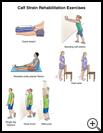
Calf Strain Exercises
Your healthcare provider may recommend exercises to help you heal. Talk to your healthcare provider or physical therapist about which exercises will best help you and how to do them correctly and safely.
You can start these exercises 4 to 5 days after your injury. When stretching, you should feel only a gentle pull and not a sharp pain in your calf while you are doing the stretch.
Wearing a quarter to half-inch heel lift in each shoe might reduce your pain as you start to recover from your injury. You can purchase heel lifts at most pharmacies. You can stop using the heel lift when you have no pain while walking.
- Towel stretch: Sit on a hard surface with your injured leg stretched out in front of you. Loop a towel around your toes and the ball of your foot and pull the towel toward your body keeping your leg straight. Hold this position for 15 to 30 seconds and then relax. Repeat 3 times.
After you can do the towel stretch easily, you can start the standing calf stretch.
- Standing calf stretch: Stand facing a wall with your hands on the wall at about eye level. Keep your injured leg back with your heel on the floor. Keep the other leg forward with the knee bent. Turn your back foot slightly inward (as if you were pigeon-toed). Slowly lean into the wall until you feel a stretch in the back of your calf. Hold the stretch for 15 to 30 seconds. Return to the starting position. Repeat 3 times. Do this exercise several times each day.
After a couple days of stretching, you can begin strengthening your calf and lower leg muscles using elastic tubing as described in the next exercise.
- Resisted ankle plantar flexion: Sit with your injured leg stretched out in front of you. Loop the tubing around the ball of your foot. Hold the ends of the tubing with both hands. Gently press the ball of your foot down and point your toes, stretching the tubing. Return to the starting position. Do 2 sets of 15.
You may do the last 5 exercises when you can stand on your toes without pain.
- Heel raise: Stand behind a chair or counter with both feet flat on the floor. Using the chair or counter as a support, rise up onto your toes and hold for 5 seconds. Then slowly lower yourself down without holding onto the support. (It's OK to keep holding onto the support if you need to.) When this exercise becomes less painful, try doing this exercise while you are standing on the injured leg only. Repeat 15 times. Do 2 sets of 15. Rest 30 seconds between sets.
You can challenge yourself by standing on just your injured leg as you do this exercise.
- Single leg balance: Stand without any support and try to balance on your injured leg. Keep standing on the one leg for 30 seconds. Repeat 3 times. Begin with your eyes open and then try to do the exercise with your eyes closed. When you have mastered this, try doing the exercise standing on a pillow.
- Nose touch: Stand on one leg facing a wall. Stand 4 inches (10 centimeters) from the wall. Keep your body and leg straight. Slowly lean forward, trying to touch your nose to the wall and then return to the starting position. Make sure you do not bend forward at your waist. Do 2 sets of 10.
- Wall jump: Face a wall and place a piece of masking tape about 2 feet (50 to 60 centimeters) above your head. Jump up with your arms above your head and try to touch the piece of tape. Make sure you do a "spring" type of motion and try to land softly on your feet. As the exercise gets easier, jump on just your injured leg. Do 2 sets of 15.
When you can do these exercises without pain, you can start a light jogging program. You can return to your sport when there is no difference between your injured side and noninjured side when you do the exercises.
Last modified: 2017-05-31
Last reviewed: 2017-05-31

